|
Hawk /
Testor's 1/48 scale
McDonnell
F2H-2 Banshee
by Don Fogal
|
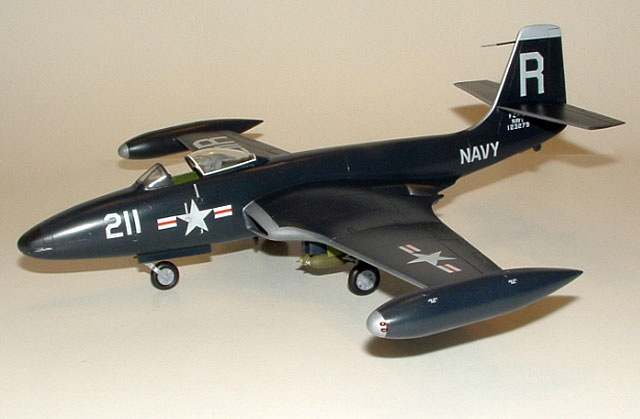 |
|
McDonnell F2H-2
Banshee |

HyperScale is proudly supported by Squadron
I finished this Banshee while taking a break from my
SR-71 Blackbird project. I started it about a year
ago...
I started this one off with the Testors 1/48th
scale kit, originally released in 1957 by Hawk Model
Company. Testor then acquired the molds, and
re-released it.
The 2 reviews I had read listed many inaccuracies in
the kit, some were easy fixes, most were not…
After reading my references, and looking over the
kit, I decided I could tackle most of the problems
in similar ways to the guys whom I had read. My
repairs ranged from simple fixes to major surgery.
My one indispensable reference was Squadron/ Signal
FH/F2H Banshee in Action, Number 182.
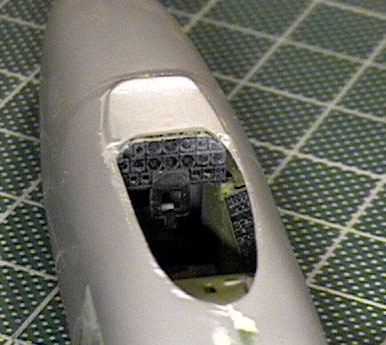 Anyone
having built Tamiya’s F4D Skyray will recognize the
new cockpit. I used some other parts from my spare
parts box. Anyone
having built Tamiya’s F4D Skyray will recognize the
new cockpit. I used some other parts from my spare
parts box.
I wanted to pose the canopy open, but the canopy
rails were molded on the fuselage halves. So after
gluing the fuselage together, I used a sharp scribe
to cut the rails free. The rails were cleaned up,
the glass attached, and a new front frame was made
from stock.
The whole assembly was sanded, polished and given
a “Future” dip. I really couldn’t be sure about the
size of the canopy, so it was left as is. I used the
tape from a “P-Touch” label maker for the white
stripe around the canopy glass. It was cut in to
narrow strips, applied, and then secured using more
Future.
I built a new nose landing gear bay, tail hook bay,
and Intake splitter plates from plastic stock. For
the intakes, I cut slots in the wing, parallel to
the fuselage, and inserted the plastic card, then
sanded them flush with the wings surface. I really
should have continued, and built intake trunks, but
hindsight is 20/20. All the landing gear doors are
new, fashioned from stock. The kit doors were rather
thick, and crude.
The pitot is new, as is the blade antenna on the
belly. The tail hook is also new, compliments of the
spare parts box.
The fuel tanks are moved back approximately 1/8 th
of an inch. They also needed to be hung lower on the
wing, not centered, or parallel with the span.
Position lights were added to the front of the tanks
also. These were carefully cut from the tail of an
old ESCI Skyraider kit, and glued in place.
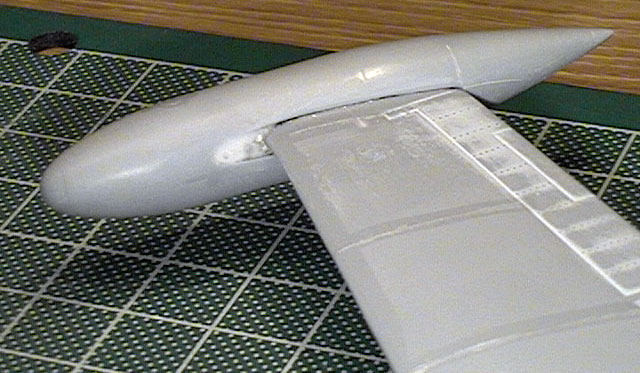
The wings would have had a 1/8th inch gap
between the top surface of the wing, and the
fuselage if left alone. I built a new section using
laminations of plastic stock, and a lot of Squadron
putty.
The biggest, and main problem is with the overall
dimensions of the model. For the F2H –2, the model
is too short. The model measures out as a –1,
approximately ¼” too short. So, being that I wanted
to build this plane for my Korean War aircraft
collection, I needed a –2. The actual -2 aircraft
was 14 inches longer than the –1. The increase in
length was to add more internal fuel space.
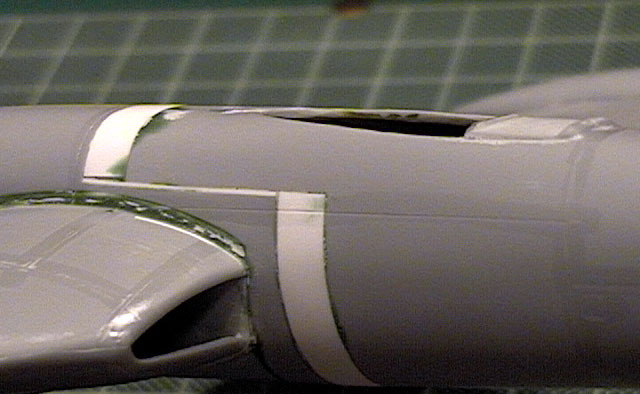
After reading, studying the pictures and drawings in
the ‘In Action’ book, It was easy to see where the
new section should be, just ahead of the wings, and
aft of the cockpit. So, I cut along the appropriate
panel lines, and built a new section, using more
plastic stock. It worked out better than I thought
it could have.
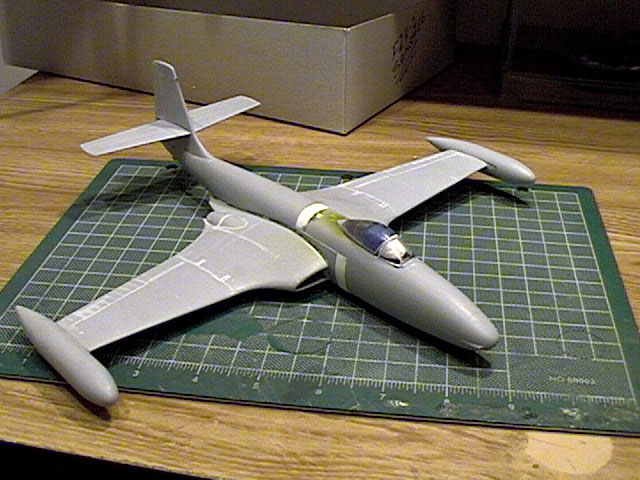
The whole model was sanded smooth, removing the
raised panel lines, including the raised lines for
the decals. Then the whole plane is re-scribed.
 The
plane was then painted with Model Master’s Gloss
Dark Sea Blue, the leading edges of the wings,
tanks, and tail surfaces are Aluminum. I chose the
markings for VF-172, USS Essex, Korea. VF-172 was
the first Banshee squadron to deploy to Korea. The
markings were all picked out of my spare decal
library, with the exception of the Buno. which was
used from the kit. The panel lines were highlighted
using a Dark Gray wash, some weathering here and
there, then I sealed the plane with a Semi-Gloss, to
help replicate the sun bleached, salt exposed
finish. The
plane was then painted with Model Master’s Gloss
Dark Sea Blue, the leading edges of the wings,
tanks, and tail surfaces are Aluminum. I chose the
markings for VF-172, USS Essex, Korea. VF-172 was
the first Banshee squadron to deploy to Korea. The
markings were all picked out of my spare decal
library, with the exception of the Buno. which was
used from the kit. The panel lines were highlighted
using a Dark Gray wash, some weathering here and
there, then I sealed the plane with a Semi-Gloss, to
help replicate the sun bleached, salt exposed
finish.
As a fighter the Banshee wasn’t able to keep up with
the new Soviet built Mig-15, so, it was used as a
bomber. It excelled in this role, especially from
the viewpoint of the Marines on the ground, whom
where protected by Banshees acting in the close air
support role.
The 20mm cannon ports in the nose were drilled out,
I borrowed some 500 lbs. bombs from my A-26 Invader
kit, and the pylons came from an old F9F Panther
kit. So now my Banshee is armed with more than just
*screams.

(* For anyone who didn’t know, McDonnell Aircraft
Company, later McDonnell Douglas, kept a tradition
of naming it’s aircraft after supernatural, or
ethereal beings, i.e. Phantom, Banshee, Demon,
Goblin.
Banshees are “apparitions” whom roam the moors, and
county sides of Scotland. It is said to hear the
scream of a Banshee was a evil omen, and the sounds
of their screams were so loud, and horrifying, that
it would scare men to near death, turning their hair
white with fear.)
Now, I’m not saying my Banshee is totally
accurate, but I think I captured a much closer
representation after all the work was put in. I had
fun with the challenges in improving what is the
only injection molded 1/48th scale
Banshee available.
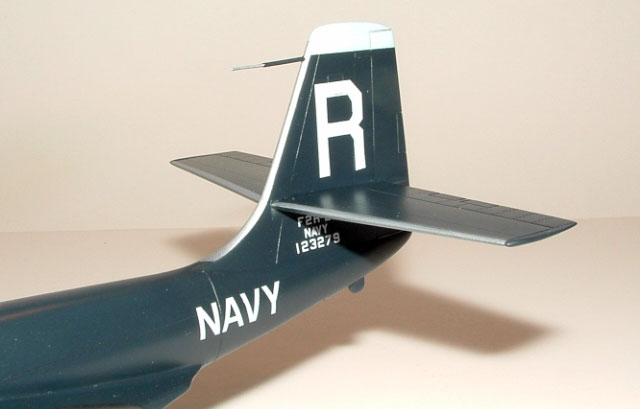
I’m happy with it, and that’s what counts!
Jim Mesko/Squadron FH/F2H Banshee in Action
Scott Van Aken Modeling Madness
Steve Mesner Modeling Madness
Darren Roberts Aircraft Resources Center
Semper Fi, Don
Click the
thumbnails below to view larger images:
[../../photogallery/photo00016318/real.htm]
Model,
Images & Text Copyright © 2007 by
Don Fogal
Page Created 17 January, 2007
Last Updated
24 December, 2007
Back to
HyperScale Main Page |
Home
| What's New |
Features |
Gallery |
Reviews |
Reference |
Forum |